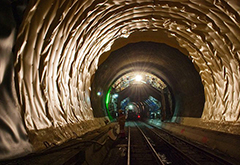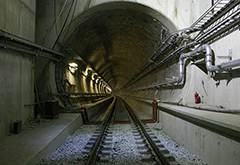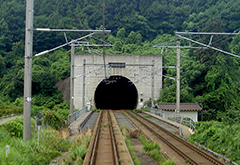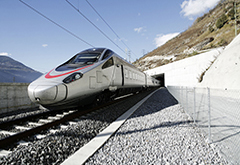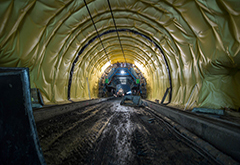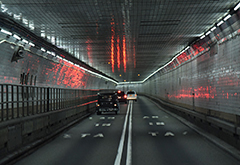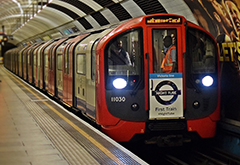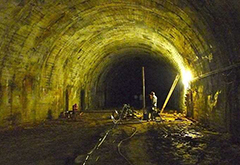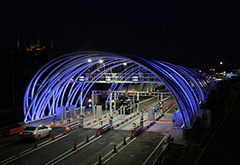Tunnels
1. Gotthard Base Tunnel:
The Gotthard Base Tunnel is a railway tunnel through the Alps in Switzerland. It opened on 1 June 2016, and full service began on 11 December 2016. With a route length of 57.09 km (35.5 mi), it is the world's longest and deepest traffic tunnel and the first flat, low-level route through the Alps. It lies at the heart of the Gotthard axis and constitutes the third tunnel connecting the cantons of Uri and Ticino, after the Gotthard Tunnel and the Gotthard Road Tunnel. The link consists of two single-track tunnels connecting Erstfeld (Uri) with Bodio (Ticino) and passing below Sedrun (Graubünden). More detailsThe Channel Tunnel is a 50.45-kilometre (31.35 mi) rail tunnel linking Folkestone, Kent, in the United Kingdom, with Coquelles, Pas-de-Calais, near Calais in northern France, beneath the English Channel at the Strait of Dover. At its lowest point, it is 75 m (250 ft) deep below the sea bed and 115 m (380 ft) below sea level. At 37.9 kilometres (23.5 mi), the tunnel has the longest undersea portion of any tunnel in the world, although the Seikan Tunnel in Japan is both longer overall at 53.85 kilometres (33.46 mi) and deeper at 240 metres (790 ft) below sea level. The speed limit for trains in the tunnel is 160 kilometres per hour (99 mph). More details
3. Seikan Tunnel:
The Seikan Tunnel is a 53.85 km (33.46 mi) dual gauge railway tunnel in Japan, with a 23.3 km (14.5 mi) long portion under the seabed. The track level is about 100 metres (330 ft) below the seabed and 240 m (790 ft) below sea level. It extends beneath the Tsugaru Strait — connecting Aomori Prefecture on the main Japanese island of Honshu with the northern island of Hokkaido — as part of the standard gauge Hokkaido Shinkansen and the narrow gauge Kaikyō Line portion of the Hokkaido Railway Company (JR Hokkaido)'s Tsugaru-Kaikyō Line. The tunnel was opened on 13 March 1988, having cost a total of ¥1.1 trillion (US$7 billion) to construct, almost 12 times the original budget, much of which was due to inflation over the years. More details
4. Lötschberg Base Tunnel:
The Lötschberg Base Tunnel (LBT) is a 34.57-kilometre (21.48 mi) railway base tunnel on the BLS AG's Lötschberg line cutting through the Bernese Alps of Switzerland some 400 m (1,312 ft) below the existing Lötschberg Tunnel. It runs between Frutigen, Berne, and Raron, Valais, and was built as one of the two centerpieces of the NRLA project. Breakthrough was in April 2005 and construction ended in 2006. The opening ceremony was in June 2007 Full scale operation began in December 2007, and the link is currently saturated because a single-track section greatly reduces its capacity. More details
5. Brenner Base Tunnel:
The Brenner Base Tunnel is a planned 55-kilometre-long (34 mi) railway tunnel through the base of the Eastern Alps beneath the Brenner Pass. It will run from near Innsbruck, in Austria, to Fortezza, in Italy, replacing part of the current Brenner railway. The line is part of Line 1, the Berlin to Palermo route, of Trans-European Transport Networks (TEN-T). The Brenner Pass, in the Alps at the border between Austria and Italy, is one of the most important traffic connections between northern and southern Europe, and the motorway going over it is infamous for its frequent traffic jams. Pollution from this traffic is a major concern. More details
6. Kuala Lumpur SMART Tunnel:
The Stormwater Management And Road Tunnel (SMART Tunnel), is a storm drainage and road structure in Kuala Lumpur, Malaysia, and a major national project in the country. The 9.7 km (6.0 mi) tunnel is the longest stormwater drainage tunnel in South East Asia and second longest in Asia. The main objective of this tunnel is to solve the problem of flash floods in Kuala Lumpur and also to reduce traffic jams along Jalan Sungai Besi and Loke Yew flyover at Pudu during rush hour. There are two components of this tunnel, the stormwater tunnel and motorway tunnel. It is the longest multi-purpose tunnel in the world. More details
7. Thames Tideway Tunnel:
The Thames Tideway Tunnel is an under-construction 25 km (16 mi) tunnel running mostly under the tidal section of the River Thames through central London, which will provide capture, storage and conveyance of almost all the combined raw sewage and rainwater discharges that currently overflow into the river. Thames Tideway TunnelBazalgette Tunnel Limited (BTL) is the licensed 'Infrastructure Provider' set up to finance, build, maintain and operate the Thames Tideway Tunnel. BTL is a consortium of investors that comprises Allianz, Amber Infrastructure, Dalmore Capital and DIF. From the licence award, BTL trades and is known to the public as 'Tideway'. More details
8. Holland Tunnel:
The Holland Tunnel is a vehicular tunnel under the Hudson River. It connects Manhattan in New York City, New York, to the east, and Jersey City, New Jersey, to the west. An integral conduit within the New York metropolitan area, the Holland Tunnel is operated by the Port Authority of New York and New Jersey (PANYNJ). The tunnel carries Interstate 78; the New Jersey side is also designated the eastern terminus of Route 139. Holland TunnelPlans for a fixed vehicular crossing over the Hudson River were first devised in 1906. However, disagreements prolonged the planning process until 1919, when it was decided to build a tunnel under the river. More details
9. Victoria Line:
The Victoria line is a London Underground line that runs between Brixton in south London and Walthamstow Central in the north-east, via the West End. It is a light blue line on the Tube map and is one of the only two lines on the network to run entirely below ground, the other being the Waterloo & City line. The line was constructed in the 1960s and was the first entirely new Underground line for 50 years. It was designed to relieve congestion on other lines, particularly the Piccadilly line and the Charing Cross branch of the Northern line. The first section, from Walthamstow Central to Highbury & Islington, opened in September 1968 and an extension to Warren Street followed in December. More details
10. Tunnels History:
A tunnel is an underground passageway, dug through the surrounding soil/earth/rock and enclosed except for entrance and exit, commonly at each end. A pipeline is not a tunnel, though some recent tunnels have used immersed tube construction techniques rather than traditional tunnel boring methods. A tunnel may be for foot or vehicular road traffic, for rail traffic, or for a canal. The central portions of a rapid transit network are usually in the tunnel. Some tunnels are aqueducts to supply water for consumption or for hydroelectric stations or are sewers. Utility tunnels are used for routing steam, chilled water, electrical power or telecommunication cables, as well as connecting buildings for convenient passage of people and equipment. More details11. Eurasia Tunnel:
The Eurasia Tunnel (Avrasya Tüneli) is a road tunnel in Istanbul, Turkey, crossing underneath the Bosphorus strait. The tunnel was officially opened on 20 December 2016 and opened to traffic on 22 December 2016. Eurasia TunnelThe 5.4 km (3.4 mi) double-deck tunnel connects Kumkapı on the European part and Koşuyolu, Kadıköy, on the Asian part of Istanbul with a 14.6 km (9.1 mi) route including the tunnel approach roads. It crosses the Bosphorus beneath the seabed at a maximum depth of −106 m. It is about 1 km south of the undersea railway tunnel Marmaray, which was opened on 29 October 2013. The journey between the two continents takes about 5 minutes. More details

